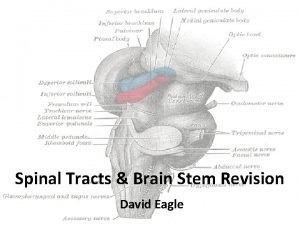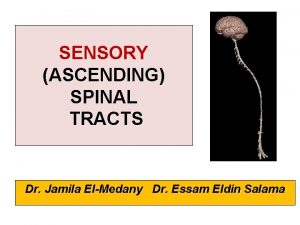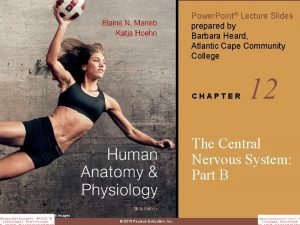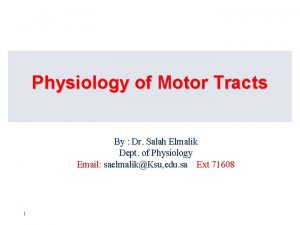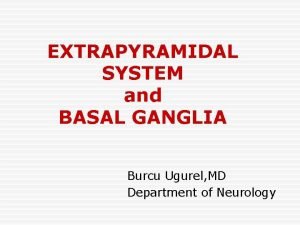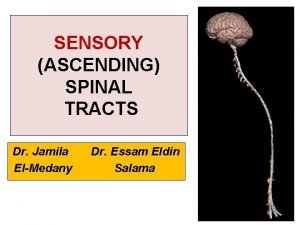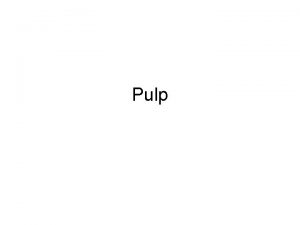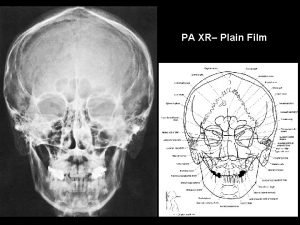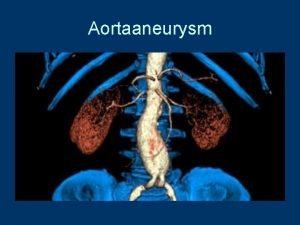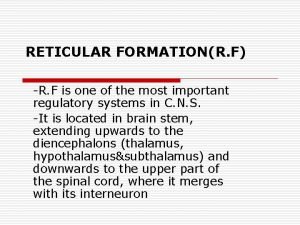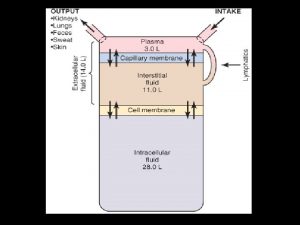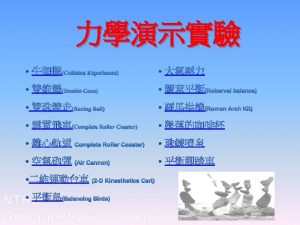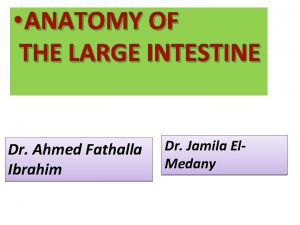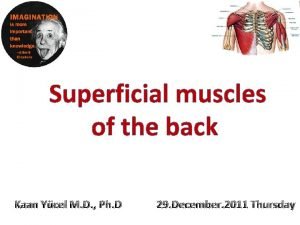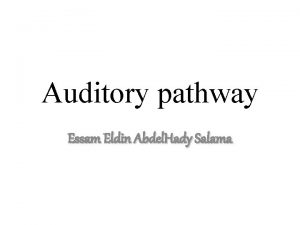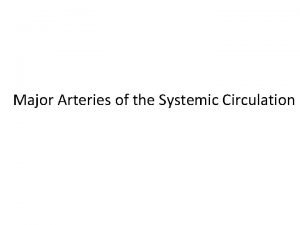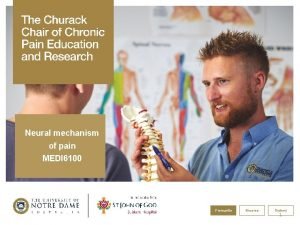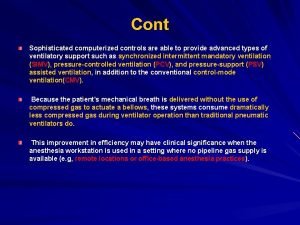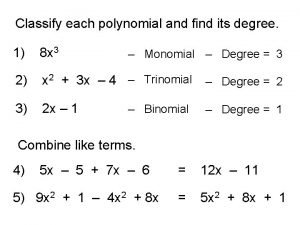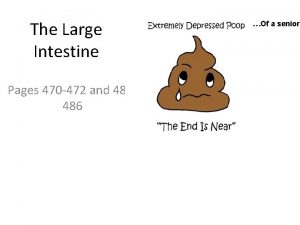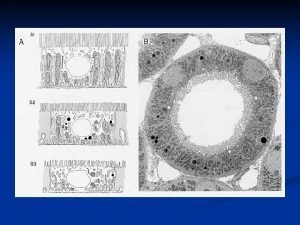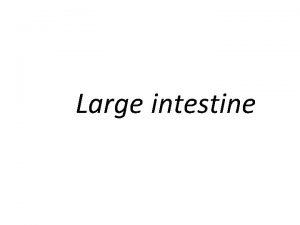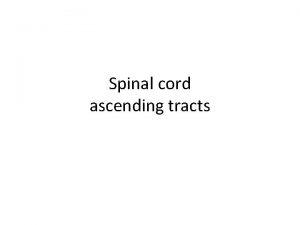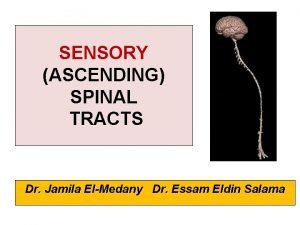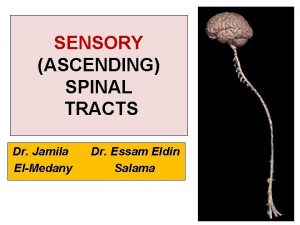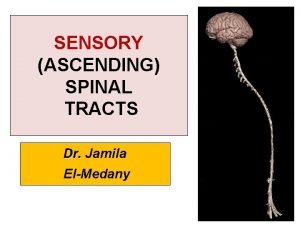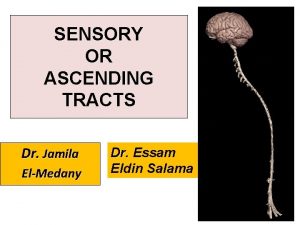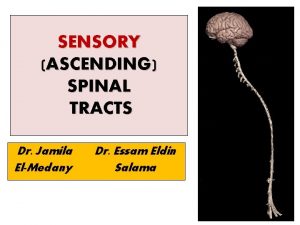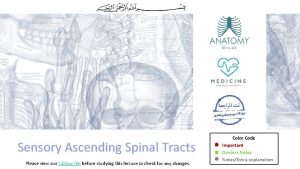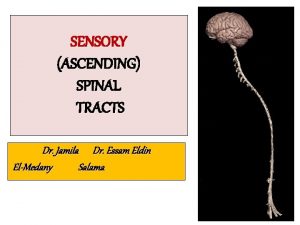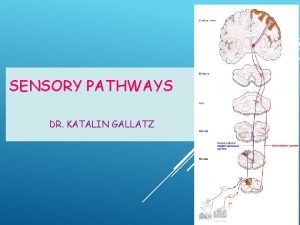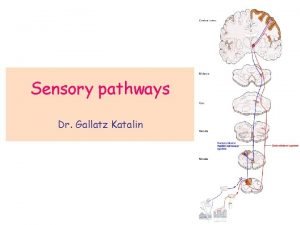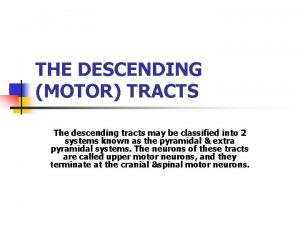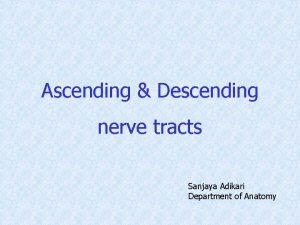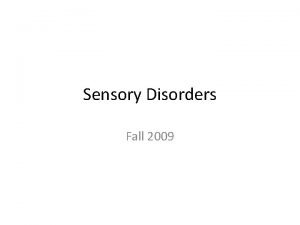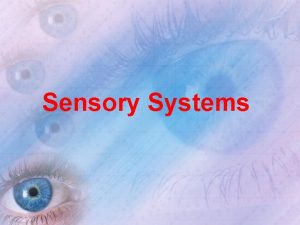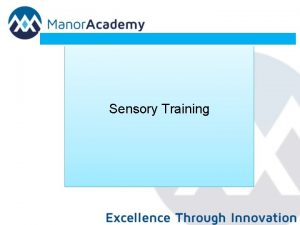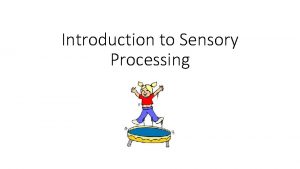THE SENSORY PATHWAYS ASCENDING TRACTS l l Each
































- Slides: 32

THE SENSORY PATHWAYS (ASCENDING TRACTS) l l Each of the various sensory pathways consists of 3 order neurons. -The first of which are the afferent nerves which have their cell bodies located in the dorsal root ganglia. -The second neurons from bundles called the ascending tracts →sub cortical centers -The 3 ed neurons arise &transmit impulses to the c. c. There are 2 systems of ascending tracts, the anterolateral &the dorsal column lemniscal systems

THE ANTEROLATERAL SYSTEM l This system consists mainly of the lateral &ventral spinothalamic tracts

The ventral spinothaamic tract l l This tract transmits crude touch &pressure as well as tickles &itches sensations. Its pathway consists of 3 neurons. First order neurons: These are A- delta &C afferent nerve fibers. They enter the spinal cord via the dorsal roots &terminate at the main sensory nucleus in lamina II, III, &IV of the dorsal horn.

The ventral spinothaamic tract l l Second order neurons: These constitute the tract. They start in the dorsal horn, cross to the opposite side, ascend in the anterior column of spinal cord, &terminate at the ventrobasal thalamic complex. Third order neurons: These start in the thalamus, pass in the sensory thalamic radiation&terminate at the cortical sensory areas in the post central gyrus.

The lateral spinothalamic tract l l This tract transmits pain& thermal sensation. It consists of the following 3 neurons. First order neurons: These are thin unmyelinated C&myelinated A delta nerve fibers that have their cells of origin in the dorsal root ganglia, and occupy mostly the lateral division of the dorsal nerve roots. They enter the spinal cord&finally relay with the cells of the substantia gelatenosa of Rolandi (S. G. R).

The lateral spinothalamic tract l l Second order neurons: These start from S. G. R, cross to the opposite side(close to the central canal)&ascend in the lateral column of the spinal cord then through the brain stem to terminate in the lateral part of the posteroventral nucleus of thalamus(P. V. N. T) Third order neurons: These start from the thalamus, travel through the posterior limb of internal capsule in the sensory radiation &terminate in the sensory areas of the cerebral cortex located in the post central gyrus where the body is represented in an inverted manner.

Gracile &cuneate tracts (Dorsal column) l l l These tracts transmit the following sensations: a-Fine touch sensation (tactile localization , tactile discrimination, steriognosis&texture of materials). b-Pressure &muscle tension sensations. c-Vibration sense. d-Kinesthetic sensations(sense of position&movement of joints).

Gracile &cuneate tracts (Dorsal column) l l l Both tracts occupy the dorsal column of the spinal cord. The gracile tract transmits the sensations from the lower parts of the body , while the cuneate tract transmits them from the upper parts of the body. These tracts are formed of 3 neurons: First order neurons: These are thick myelinated A beta fibers they enter the spinal cord &ascend directly in the dorsal column, till relaying with the gracile &cuneate nuclei in the medulla oblongata.

Gracile &cuneate tracts (Dorsal column) l l Second order neurons: These start from the gracile &cuneate nuclei, cross to the opposite side in the sensory decusation, then the fibers ascend as the medial lemniscus &relay in the thalamus with the P. V. N. T. Third order neurons: These start from the thalamus , travel through the posterior limb of internal capsule in the sensory radiation &terminate, as in case of the spinothalamic tracts, in the sensory areas of the cerebral cortex located in the post central gyrus.

Spinocerebellar tracts l l These tracts transmit proprioceptive sensation subconsciously to the cerebellum. This play an essential role in the control of muscle tone &coordination of voluntary movements. First order neurons are collaterals from the first order neurons of the gracil&cuneate tracts, &they terminate on the Clark's cells present at the base of the dorsal horns.

Spinocerebellar tracts l l Second order neurons start from the Clark's cells &ascend in the lateral column of the spinal cord till reaching the brain stem where fibers of the dorsal tract enter the cerebellum through the inferior cerebellar peduncle while those of the ventral tract enter through the superior peduncle &both terminate at the vermis of the cerebellum. Third order neurons start from the vermis &terminate in the cerebellar cortex.

Spinotectal tract l This tract transmits various afferent impulses to the superior colliculus at the tectum of the midbrain where it subserves spinovesual reflexes (e. g. moving the eyes towards a source of stimulation).

Spino-olivary tract l This tract arises from the cells if the dorsal horn &ascend in the lateral column of the spinal cord, terminating at the inferior olivary nuclei in the medulla oblongata, where it probably transmits proprioceptive impulses to the cerebellum.

Other ascending tracts l l -Spinoreticular tract: This tract terminates at the RF in the BS &is concerned with maintenance of consciousness. -Spinovestibular tract: This tract terminates at the lateral vestibular nucleus in the MO &concerned with certain postural reflexes.

SENSORY DISTURBANCES l l Sensory disturbances occur in the thalamic syndrome, spinal cord lesions, syrigomyelia, tabes dorsalis&polyneuritis. 1 -SYRINGOMYELIA: This is a slowly progressive disease that is probably congenital in origin. It occurs at middle age &females are more affected. There is abnormal cavitation around the central canal of the spinal cord. Manifestations:

1 -SYRINGOMYELIA l l 1 -Dissociated sensory loss: (loss of some sensations &preservation of others). Because the lesion damages the crossing fibers of the lateral spinothalamic tracts in front of the central canal, there is bilateral loss of pain &temp. Sensations at the level of the lesion. On the other hand, fine tactile &proprioceptive sensations are preserved. The lesion usually affects the lower cervical &upper thoracic segments of the spinal cord, so its manifestations often have a jacket distribution

1 -SYRINGOMYELIA l l 2 -Bilateral muscle paralysis at the level of the lesion(LMNL). 3 -Weakness of the lower limb muscles.

II-TABES DORSALIS l l This is a nervous isease that occurs in the late stage of neurosyphilis as a result of inflammation of the posterior nerve roots. Manifestation: 1 -Early manifestations: a)-Attacks of severe pain duo to irradiation of the pain –conducting afferent nerve fibers by the inflammatory process.

II-TABES DORSALIS l b)-Degeneration of the gracile &cuneate tracts&no regeneration occurs because these tracts have no neurolemma sensory ataxia(Romberg' sign +ve) &↓(fine touch sensation , discrimination…).

II-TABES DORSALIS: l l l 2 -Late manifestations: a)-Loss of all sensations in the regions innervated by the affected dorsal nerve roots. b)-Loss of all reflexes mediated by the affected dorsal nerve roots (superficial. deep&visceral reflexes).

III-POLYNEURITIS(peripheral neuropathy): l l l l It is characterized by widespread bilateral &symmetrical degeneration of the peripheral nerves in the limbs. Causes of polyneuritis: 1 -Vitamin B deficiency (vit B 1) 2 -Metabolic causes (DM). 3 -Toxic causes-endogenous (uremia) or- exogenous (lead, mercury. . ) 4 -Nerve infections (leprosy, diphtheria&tetanus). 5 -Endocrine causes (hyperthyroidism&acromegaly) 6 -Vascular causes(atherosclerosis).

Manifestations: l l l 1 -Sensory disturbances : ( paraesthesia, hypoesthesia) occurs in the peripheral parts of the limbs, taking a glove&stocking distribution. 2 - Motor disturbances: Bilateral LMNL&loss of superficial &deep reflexes. 3 -Autonomic disturbances : ( trophic ulcers)

COMPLETE TRANSECTION OF THE SPINAL CORD: l l l The patient with complete transaction of the spinal cord passes in 3 stages: A-Stage of spinal shock: Manifestations: 1 -Loss of all sensations below the level of the lesion. 2 -Paraplegia or quadriplegia 3 -V. D below the level of the lesion due to interruption of the descending fibers from the vasomotor center.

COMPLETE TRANSECTION OF THE SPINAL CORD: l l l 4 -Loss of spinal reflex activity below the level of the lesion because the spinal centers at this part become functionless(e. g. withdrawal, stretch visceral reflexes) , Cause of spinal shock is due to sudden withdrawal of supraspinal facilitation on the α motor neurons. It is not a hypotensive shock. Duration of the spinal shock: This varies directly with the degree of encephalization(e. g. it is only a few minutes in frogs&rats , 1 -2 hours in dogs &cats, several days in monkeys &2 -6 weeks in man.

Complications of spinal shock: l l l 1 -Hypotension 2 -Increased protein catabolism(due to lack of movement)causing muscle wasting &bone dissolution. 3 -Iscaemia of the areas compressed against bed(gluteal region, heels. . )So these areas are liable to ulceration( bed sores) 4 -UTI due to urine stasis. 5 -Fall of body temp(due to reduction of the metabolic rate after loss of the muscle tone)

MANAGEMENT OF SPINAL SHOCK: l l l 1 -Giving antibiotics to prevent infection anywhere. 2 -Giving stimulants to the spinal centers (amphetamine) 3 -Bladder catheterization 4 -Prevention of bed sores by cleaning the skin with antiseptics &frequent changing the patient's position in bed. 5 -Adequate nutrition (malnutrition delays spinal recovery

b-Stage of recovery of spinal reflex activity: l After spinal shock, the spinal centers below the level of the lesion recovery gradually(but the sensations&voluntary monement never recover because the tracts in the spinal cord cannot regenerate due to lack of neurolemma.

POSSIBLE MECHANISM OF SPINAL RECOVERY l l l 1 -Release of the spinal centers from the normal inhibitory control of the higher centers. 2 -Denervation hypersensitivity(the spinal neurons become hypersensitive to the transmitters released by any remaining excitatory nerves) 3 -Growth of new collaterals from existing neurons with formation of additional excitatory endings on spinal neurons.

C-Stage of failure of spinal reflex activity l l l This is a terminal stage that usually results from bad management during the recovery stage. It is often associated with general toxemia due to either bed sores, infection or a urinary tract infection (which may lead to uremia). The spinal centers below the level of the lesion are depressed once more leading to the following: 1 -Loss of the muscle tone &tendon jerks , then the withdrawal reflex, &Babinski’s sign. ( flaccid paralysis &the body temp. falls). 1 -Loss of the defecation &micturition reflexes→constipation &urine retention with overflow. 3 -Hypotension due to depression of the spinal V. C centers.

HEMISECTION OF THE SPINAL CORD(BROWN –SEQUARD SYNDROME) l l This is a unilateral transvers lesion in the spinal cord that interrupts the continuity of both the ascending and descending tracts at only one half. Such lesion causes the following:

HEMISECTION OF THE SPINAL CORD 1 -Above the level of the lesion: Cutaneous hyperaesthesia(increased sensibility to pain, touch &tempe. )due to irritation of these roots by the trauma. 2 -At the level of the lesion: The following effects occur on the same side: -Loss of all sensations in the areas innervated by the afferent nerves that enter the damaged segments. -Paralysis of the muscles supplied by the efferent nerves(LMNL) -Loss of all reflexes mediated via the damaged segments.

HEMISECTION OF THE SPINAL CORD 3 -Below the level of the lesion: 1 -Paralysis of the muscles of the UMNL type on the same side. 2 -V. D. in the same side. 3 -Sensory disturbances: -Ipsilateral loss of fine tactile , proprioceptive , pressure &vebration sensations. -Controlateral analgesic &athermia. -Crude touch is diminished on both sides.
 Ascending tracts
Ascending tracts Spinoreticular tract
Spinoreticular tract Spinal cord
Spinal cord Ligamentum denticulatum
Ligamentum denticulatum Inferior view of brain
Inferior view of brain Vestibulospinal tract
Vestibulospinal tract Premotor cortex
Premotor cortex Exercise 15 spinal cord and spinal nerves
Exercise 15 spinal cord and spinal nerves Pyramidal and extrapyramidal tracts
Pyramidal and extrapyramidal tracts Cerebellar signs
Cerebellar signs Vestibulospinal tract origin
Vestibulospinal tract origin Zone of the pulp
Zone of the pulp Film
Film Indian and international number system
Indian and international number system Infrarenalt
Infrarenalt Chromatography biochemistry
Chromatography biochemistry Reticular system
Reticular system Dissimilar fractions
Dissimilar fractions Ascending order of decimals examples
Ascending order of decimals examples Boston marathon
Boston marathon Balancing cones
Balancing cones Sigmoid colon peritoneum
Sigmoid colon peritoneum Descending part of trapezius
Descending part of trapezius Ascending auditory pathway
Ascending auditory pathway Ascending levels of intellectual demand
Ascending levels of intellectual demand Major arteries of the ascending aorta and aortic arch
Major arteries of the ascending aorta and aortic arch Somatic pain pathway
Somatic pain pathway Ascending bellows
Ascending bellows Ascending christology
Ascending christology Identify the polynomial written in ascending order.
Identify the polynomial written in ascending order. Haustrum of colon
Haustrum of colon Thin ascending limb
Thin ascending limb Large intestine
Large intestine
